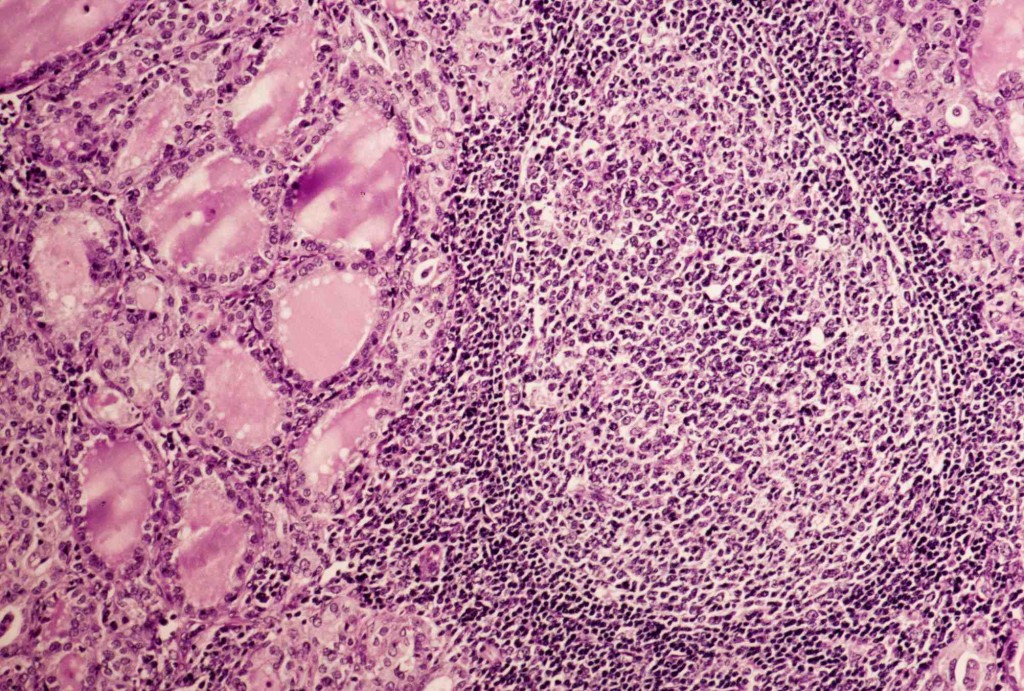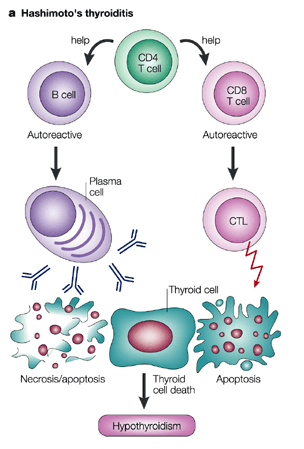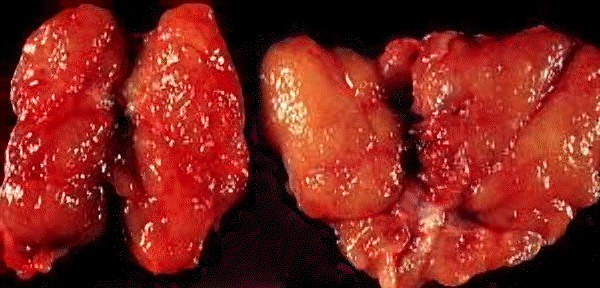Hashimoto's thyroiditis
In Hashimoto 's thyroiditis ( Hashimoto's lymphomatous Synonyms goiter, lymphocytic thyroiditis and Ord 's thyroiditis ) is an autoimmune disease that causes chronic inflammation of the thyroid gland. In this disease thyroid tissue is destroyed due to a misdirected immune process by T-lymphocytes. In addition, production of antibodies against thyroid -specific antigens can be detected. This disease was named after the Japanese physician Hashimoto Hakaru (1881-1934), who described it in 1912 as the first. The character as an autoimmune disease was detected by Deborah Doniach and Roitt Ivan.
General
There are two different forms of course well-known:
- Hashimoto's thyroiditis i.e.S. ( Autoimmunthyreopathie Type 1A and 2A ), with an enlargement (hypertrophy ) of the thyroid gland ( " crop " or " goiter ").
- The Ord 's thyroiditis ( Autoimmunthyreopathie Type 1B and 2B), with a reduction (atrophy ) of the thyroid gland. It was named after William Miller Ord, who described it in 1878.
Since the symptoms, diagnosis, treatment and prognosis of the two forms do not differ significantly and both forms may merge into one another in each case, they are now usually combined under the term Hashimoto 's thyroiditis. In both progression ( the atrophic form is much more common than the hypertrophic form), it depends on duration of hypothyroidism, with onset of the disease - caused by the destruction of thyroid tissue - can also show phases of overactive (so-called "leak - hyperthyroidism " in extreme cases Hashitoxikose ). The disease is considered incurable, but highly treatable.
Hashimoto's thyroiditis is counted to the group of polyendokrinen autoimmune diseases and therefore occurs more frequently with other diseases such as Addison's disease, diabetes mellitus type I, celiac disease, vitiligo and hypoparathyroidism.
Epidemiology
Hashimoto's thyroiditis is the most common autoimmune diseases in humans and the most common cause of primary hypothyroidism. A U.S. survey found subclinical and clinically manifest at 0.3 % hypothyroidism in 10% of subjects of a population sample increased antibody at 4.3 %. A recent study found 10% of clinical and subclinical hypothyroidism. According to textbooks, the incidence of the common condition associated with Hashimoto 's thyroiditis hypothyroidism in Western Europe is 1-2 %; However, sub-clinical courses are more frequent and are in the range of 6-8%. Women are affected much more frequently than men (ratio of about 2:1 to 5:1). It can be found familial clustering, that is, there is only the predisposition to Hashimoto inherited. Observations show that the Hashimoto 's thyroiditis may occur in temporal relation to hormonal changes (puberty, childbirth, menopause ) and stress situations.
Causes
The exact mode of factors that can lead to the onset of Hashimoto 's thyroiditis, are not yet sufficiently clarified. At issue in addition to a family ( genetic ) bias are (eg X - Chromosome Inactivation ), stress, difficult viral diseases (such as mononucleosis, shingles ), dysfunction of the adrenal cortex, microchimerism and environmental impacts. Is currently being debated on the significance of excessive iodine intake for the outbreak of the disease. As a relatively safe can be said that they, like Graves' disease, due to very high Joddosen ( Jodexzess ) can be triggered (eg by iodinated contrast agents ). Hazards posed by a iodization of foods ( as a result of Futtermitteljodierung in farm animals and the Kochsalzjodierung ), are discussed (see iodine deficiency, Jodunverträglichkeit ).
Symptoms and course of disease
Because of the possible initial hyperthyroidism ( Syn Hashitoxikose ) can the symptoms are for a certain time in the foreground: nervousness, irritability, restlessness, tremors of the hands, insomnia, sweating, palpitations, and tachycardia, cardiac arrhythmias, warm, moist skin, hunger and thirst, weight loss despite good appetite and in women additionally disturbances in the menstrual cycle (irregular or increased bleeding, absence of menstruation ).
Long term, these are then replaced by symptoms of hypothyroidism: low body temperature, increased sensitivity to cold, edema ( swelling due to fluid retention, especially on eyelids, face, extremities, myxedema ), lump in the throat, feeling of pressure on or in the neck, Strangulationsgefühl ( even in phases ) frequent throat clearing and cough, hoarse or husky voice ( Stimmbandödem ), depressed mood, lack of motivation, lethargy, muscle weakness, muscle tightness, dry, cracked skin and associated itching, dry mucous membranes, brittle hair and nails, hair loss, rapid and strong (almost uncontrollable ) weight gain, nausea, indigestion, stunted growth, enlargement of the heart, slow heart rate, decreased libido, changes in cycle ( in women), eye disease ( thyroid eye disease ), joint pain, concentration and memory problems, fatigue.
The disease course is easily in the majority of patients, but are also medium and heavy courses known. The symptoms are varied and - just at the onset of the disease - difficult to classify. The variety and variability of the symptoms and the creeping course complicate the diagnosis.
Symptoms of underactive values constellations can occur because the individual values of latitude is usually much smaller than that based on statistical analysis, inter-individual reference value range even at subclinical (still euthyroid as applicable ). Even subclinical values constellations can drag a reduction in quality of life, therefore, already.
In extremely rare cases goes with the disease Hashimoto's encephalopathy associated with symptoms such as seizures, psychiatric symptoms or hallucinations.
Diagnosis
Diagnostically relevant are:
- Called thyroid peroxidase antibodies ( antibodies against thyroid peroxidase = thyroid peroxidase ) (TPO -Ab ), and microsomal antibodies (mAb )
- Antibodies against thyroglobulin (Tg -Ab )
In the vast majority of cases, the TPO antibodies are increased (with or without an increase in the Tg -ABs). In a far lower proportion of cases only the Tg antibody ( stronger) are increased. In very rare cases, there is a Hashimoto 's thyroiditis without said antibodies are detectable.
For an assessment of the metabolic status of the thyroid hormone levels following are relevant:
- TSH ( thyroid - stimulating hormone)
- T3 ( triiodothyronine ), and free T3 ( fT3 = )
- T4 ( levothyroxine = L -thyroxine thyroxine = ) or free T4 ( fT4 = )
A thyroid diagnosis, which relies solely on the TSH value is to detect Hashimoto's Thyreoidis usually not meaningful enough for even a normwertiger TSH levels or normwertige free T3 and T4 levels are no exclusion criteria for Hashimoto 's thyroiditis.
Very important for diagnosis also is a sonogram of the thyroid. Typically, the thyroid gland appears in the ultrasound image inhomogeneous and hypoechoic, indicating the ongoing process of destruction. In addition, the apparent Doppler sonogram in increased blood flow may be an indication of an inflammatory process. The size of the thyroid gland can be assessed in the sonogram. Since the hypertrophic form of Hashimoto 's thyroiditis may be associated with a goiter, sizes above about 18 ml (women) or 25 ml ( men) are to be regarded as a striking total. Small thyroid with a size below 6 ml (women) or 8 ml ( men ), however, are typical of the atrophic -onset form ( Ord 's thyroiditis ), which must be noted caveat that these sizes are - depending on the author - vary greatly and object of discussion are. In Germany the so-called atrophic waveform with a shrinking thyroid is far more common than the hypertrophic form with goiter ( goiter).
In particular, in the initial phase of the disease, the distinction between Hashimoto's thyroiditis and Graves' disease may be ( an autoimmune disease that leads to the overproduction of thyroid hormones ) is difficult, since even with Hashimoto initial overactivity relapses may exist. Usually you can then bring clarity scintigraphy.
Final proof brings the histological ( histological microscopic ) examination of thyroid tissue, which was obtained by means of a fine needle aspiration. In Hashimoto's thyroiditis reveals, in addition to other criteria, especially a dense infiltrate of lymphocytes and lymphoid follicles (see figure), which are an expression of the inflammatory processes.
Treatment
Hashimoto's thyroiditis as an autoimmune process is at present no cure and is not treated the cause. If the thyroid gland due to the chronic inflammation can no longer produce enough thyroid hormones which hypofunction through ( creeping ) substitution must be treated (→ Main article hypothyroidism).
The substitution is carried out by daily oral administration of thyroid hormones. Due to the high physiological hormone levels in the early morning hours is recommended in the morning to take the tablet about 30 minutes before the first meal. But there are different ways: the sole ingestion of thyroxine (T4, levothyroxine ) if the conversion is not disturbed of T4 to T3 in the body, or a combination of T4 and T3 either as a combined preparation with solid T4/T3-Verhältnis or free metered individual preparations.
Iodine in tablet form, however, should not be taken in addition with Hashimoto's thyroiditis, since excess iodine can promote the inflammation of the thyroid gland. The amounts of iodine contained in food are considered safe.
The TSH value and possibly also the hormone levels fT3 and fT4 must be checked regularly, because in the course of the disease can set changes that require a dose adjustment. In addition, the thyroid should be sonographically monitored at regular intervals ( every 6 to 12 months).
The successful setting often takes several months. The longer this lasts for a sub-function and the heavier it is, the more tedious it is usually to achieve a satisfactory hormonal status and well-being. Since fluctuations or surges may belong to the disease, some patience at the dose adjustment is required.
Substitution treatment is lifelong usually required. With a good attitude, the patient is symptom- free and the life expectancy is not reduced.
The addition of selenium is not yet generally recognized as effective. However, there are several studies that suggest that the supplementation of this trace element has a positive effect on the immune process.










